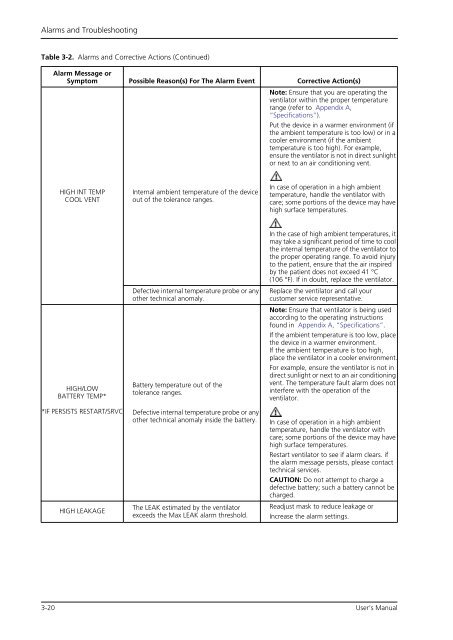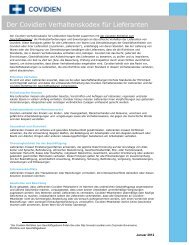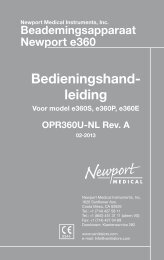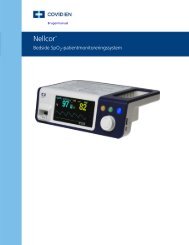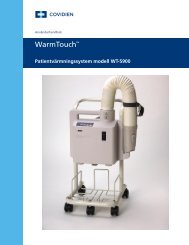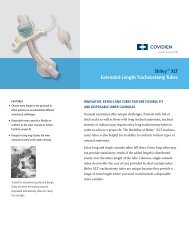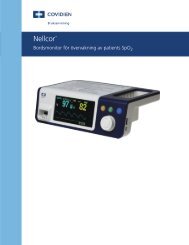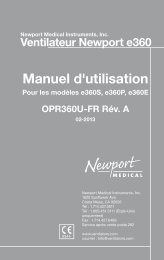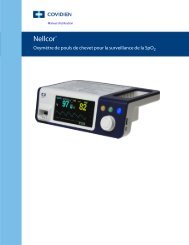Puritan Bennett 560 Ventilator User's Manual - Covidien
Puritan Bennett 560 Ventilator User's Manual - Covidien
Puritan Bennett 560 Ventilator User's Manual - Covidien
You also want an ePaper? Increase the reach of your titles
YUMPU automatically turns print PDFs into web optimized ePapers that Google loves.
Alarms and Troubleshooting<br />
Table 3-2. Alarms and Corrective Actions (Continued)<br />
Alarm Message or<br />
Symptom Possible Reason(s) For The Alarm Event Corrective Action(s)<br />
HIGH INT TEMP<br />
COOL VENT<br />
HIGH/LOW<br />
BATTERY TEMP*<br />
*IF PERSISTS RESTART/SRVC<br />
HIGH LEAKAGE<br />
Internal ambient temperature of the device<br />
out of the tolerance ranges.<br />
Defective internal temperature probe or any<br />
other technical anomaly.<br />
Battery temperature out of the<br />
tolerance ranges.<br />
Defective internal temperature probe or any<br />
other technical anomaly inside the battery.<br />
The LEAK estimated by the ventilator<br />
exceeds the Max LEAK alarm threshold.<br />
Note: Ensure that you are operating the<br />
ventilator within the proper temperature<br />
range (refer to Appendix A,<br />
“Specifications”).<br />
Put the device in a warmer environment (if<br />
the ambient temperature is too low) or in a<br />
cooler environment (if the ambient<br />
temperature is too high). For example,<br />
ensure the ventilator is not in direct sunlight<br />
or next to an air conditioning vent.<br />
In case of operation in a high ambient<br />
temperature, handle the ventilator with<br />
care; some portions of the device may have<br />
high surface temperatures.<br />
In the case of high ambient temperatures, it<br />
may take a significant period of time to cool<br />
the internal temperature of the ventilator to<br />
the proper operating range. To avoid injury<br />
to the patient, ensure that the air inspired<br />
by the patient does not exceed 41 °C<br />
(106 °F). If in doubt, replace the ventilator.<br />
Replace the ventilator and call your<br />
customer service representative.<br />
Note: Ensure that ventilator is being used<br />
according to the operating instructions<br />
found in Appendix A, “Specifications”.<br />
If the ambient temperature is too low, place<br />
the device in a warmer environment.<br />
If the ambient temperature is too high,<br />
place the ventilator in a cooler environment.<br />
For example, ensure the ventilator is not in<br />
direct sunlight or next to an air conditioning<br />
vent. The temperature fault alarm does not<br />
interfere with the operation of the<br />
ventilator.<br />
In case of operation in a high ambient<br />
temperature, handle the ventilator with<br />
care; some portions of the device may have<br />
high surface temperatures.<br />
Restart ventilator to see if alarm clears. if<br />
the alarm message persists, please contact<br />
technical services.<br />
CAUTION: Do not attempt to charge a<br />
defective battery; such a battery cannot be<br />
charged.<br />
Readjust mask to reduce leakage or<br />
Increase the alarm settings.<br />
3-20 User’s <strong>Manual</strong>


